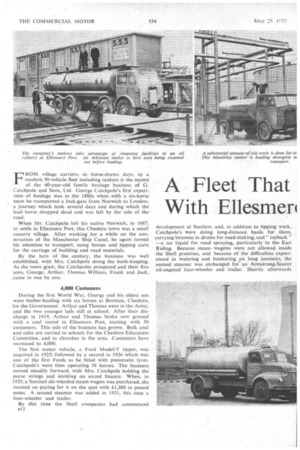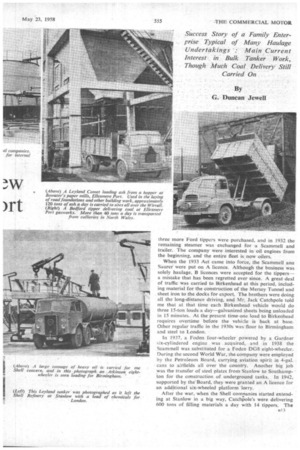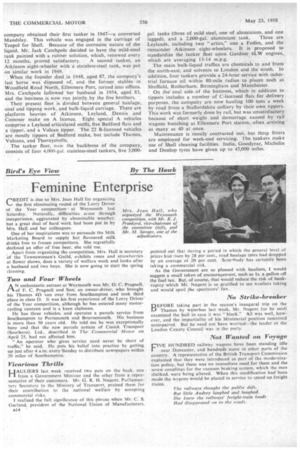A Fleet That With Ellesmen
Page 46

Page 47

Page 48

If you've noticed an error in this article please click here to report it so we can fix it.
FROM.. village •carriers,.in horse-drawn days, to a modern 50-vehicle fleet including tankers is the record of the 60-year-old family haulage business of G. Catehpole and Sons, Ltd. George Catchpole's first experience of haulage was in the 1880s when with a six-horse team he transported a lock-gate from Norwich to London, a journey which took several days and during which the lead. horse . dropped dead and was left by the side of the
road. .
When Mr.._Catchpole left his native Norwich, in 1887, to settle in Ellestnere Port, this Cheshire town was a small country village. After working for a while on the construction of the Manchester Ship Canal, he again turned his attention to transport, using horses and tipping carts for the carriage of. building and road materials.
By the turn of the century, the business was well established, with Mrs. Catchpole doing the book-keeping. As the town grew, the Catchpoles prospered and their five sons, George, Arthur, Thomas William, Frank and Jack, ,came in one by one.
4,000 Customers
During the first World War, George and his eldest son were timber-hauling with six horses at Broxton, Cheshire, for the Government. Artbur and Thomas were in the Army, and the two younger lads still at school. After their discharge in 1919, Arthur and Thomas broke new ground with a 'coal round in Ellesmere Port, starting with 30 • customers. This side of the business has grown. Bulk coal and coke are carried to schools for the Cheshire Education Committee, and to churches in the area. Customers have increased to 4,000.
The first motor vehicle, a Ford Model-T tipper, was acquired in 1925; followed by a second in 1926 which was one of the first Fords to be fitted with pneumatic tyres. Catchpole's were then operating 38 horses. The business moved steadily forward, with Mrs. CatchpoIe holding the purse strings and insisting on sound finance. When, in 1929, a Sentinel six-wheeled steam wagon was purchased, she insisted on paying for it on the spot with £1,380 in pound notes. A second steamer was added in 1931, this time a four-wheeler and trailer.
By this time the Shell companies had commenced
B12
development at Stanlow, and, in addition to tipping work, Catchpole's were doing long-distance hauls for them, carrying bitumen in drums for road-Making, and cutback" —a tar liquid for road spraying, particularly to the East ' Riding. Because steam wagons were not allowed inside the Shell premises, and because of the difficulties experienced in watering and bunkering on long journeys, the second steamer was exchanged for an Armstrong-Saurer oil-engined four-wheeler and trailer. Shortly afterwards three more Ford tippers were purchased, and in 1932 the remaining steamer was exchanged for a Scammell and trailer. The company were interested in oil engines from the beginning, and the entire fleet is now oilers.
When the 1933 Act came into force, the Scammell arta Saucer were put on A licence. Although the business was solely haulage, B licences were accepted for the tippers— a mistake that has been regretted ever since. A great deal of traffic was carried to Birkenhead at this period, including material for the construction of the Mersey Tunnel and sheet iron to the docks for export. The brothers were doing all the long-distance driving, and Mr. Jack Catchpole told me that at that time each Birkenhead vehicle would do three 15-ton loads a day—galvanized sheets being unloaded in 15 minutes. At the present timeone load to Birkenhead requires overtime before the vehicle is back at base. Other regular traffic in the 1930s was flour to Birmingham and steel to London.
In 1937, a Foden four-wheeler powered by a Gardner six-cylindered engine was acquired, and in 1938 the Scammell was substituted for a Foden DG8 eight-wheeler. During the second World War, the company were employed by the Petroleum Board, carrying aviation spirit in 4-gal. cans to airfields all over the country. Another big job was the transfer of steel plates from Stanlow to Southampion for the construction of underground tanks. In 1942, supported by the'Board, they were granted an A licence for an additional six-wheeled platform lorry.
After the war, when the Shell connnanies started extending at Stanlow in a big way, Catchpole's were delivering 600 tons of filling materials a day with 14 tippers. The company obtained their first tanker in 1947—a converted Maudslay. This vehicle was engaged in the carriage of Teepol for Shell. Because of the corrosive nature of the liquid, Mr. Jack Catchpole decided to have the mild-steel tank painted with a rubber solution, which, renewed every 12 months, proved satisfactory. A second tanker, an Atkinson eight-wheeler with a stainless-steel tank, was put on similar work in 1949.
When the founder died in 1948, aged 87, the company's last horse was disposed of, and the former stables in Woodfield Road North, Ellesmere Port, turned into offices. Mrs. Catchpole followed her husband in 1954, aged 83, and the business is now run jointly by the five brothers.
Their present fleet is divided between general haulage,. coal and tipping work, and bulk-liquid carriage. There are platform heavies of Atkinson, Leyland, Dennis and Commer make on A licence. Eight special A vehicles comprise a Leyland articulated outfit, five Bedford flats and a tipper, and a Vulcan tipper. The 22 B-licensed vehicles are mostly tippers of Bedford make, but include Thames, Vulcans, and Thornycrofts.
The tanker fleet, now the backbone of the company, consists of four 4.000-gal. stainless-steel tankers, five 3,000
gal, tanks (three of mild steel, one of aluminium, and one lagged), and a 2,000-gal. aluminium tank. Three are Leylands, including two " artics," one a Foden, and the remainder Atkinson eight-wheelers. It is proposed to standardize the tanker fleet upon Gardner 6LW engines, which are averaging 13-14 m.p.g.
The main bulk-liquid traffics are chemicals to and from the north-east, and solvents to London and the south. In addition, four tankers provide a 24-hour service with industrial furnace oil within 80-mile radius to places such as Sheffield, Rotherham, Birmingham and Manchester.
On the' coal sideof the business, which in addition to tippers includes a number of C-licensed flats for delivery purposes, the company are now hauling 100 tons a weck by road from a Staffordshire colliery by their own tippers. This work was formerly done by rail, but was unsatisfactory because of short weight and demurrage caused by rail wagons bunching at Ellesmere Port station, often arriving as many as 40 at once.
Maintenance is mostly contracted out, but three fitters are employed for week-end servicing. The tankers make use of Shell cleaning facilities. India, Goodyear, Michelin and Dunlop tyres have given up to 45,000 miles.
























































































